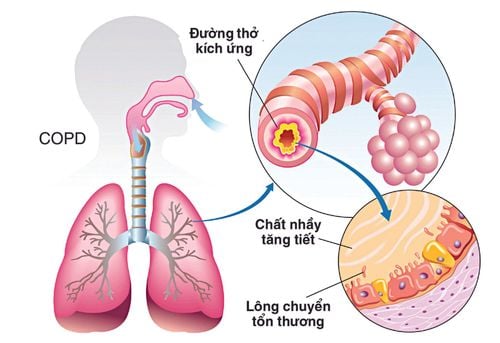This is an automatically translated article.
The article was professionally consulted by Specialist Doctor I Nguyen Truong Duc - Radiographer - Department of Diagnostic Imaging and Nuclear Medicine - Vinmec Times City International General Hospital. Dr. Duc has more than 17 years of experience in diagnostic imaging.X-ray examination is an important test in the diagnosis of respiratory diseases. Through chest imaging combined with other tests and medical history can make accurate conclusions about the disease.
1. What is bronchial asthma?
Asthma is a condition in which the body makes it difficult to breathe due to bronchospasm (narrowing of the airways) that causes increased mucus production and thickening of the airway walls. Symptoms such as wheezing, shortness of breath, chest tightness, and coughing vary with duration of illness, frequency, and intensity.Triggers that can worsen asthma symptoms include viral infections, allergens (eg, house dust mites, pollen, cockroaches), cigarette smoke, exercise, and stress. These reactions are more likely to occur when asthma is uncontrolled. Certain medications can trigger or trigger an asthma attack, such as beta-blockers and, in some patients, aspirin or other non-steroidal anti-inflammatory drugs.
2. How is asthma manifested?
Asthma has acute manifestations when exposed to irritating factors such as house dust, smoke, and pollen. Patients often have an asthma attack after being exposed to the agent for more than a few minutes. Asthma due to viral infection presents later. In general, an asthma attack goes through the following stages:Stage 1: There is evidence of bronchospasm and edema (paroxysmal cough, stagnation of mucus, mild shortness of breath during the cough). Stage 2: The secretions increase. The patient has a severe cough, increased shortness of breath, wheezing, interrupted speech, and has to sit up to breathe. Gray-blue face, purple lips, less movement of the chest, increased breathing rate, increasingly shallow breathing. Stage 3: This is the stage of severe bronchospasm. The breathing sound has a lot of wheezing, shortness of breath, cyanosis and easily stops breathing.

Cơn hen khởi phát trải qua 3 giai đoạn
3. How do X-rays help in diagnosing asthma?
A chest X-ray is a test that is used to determine if the airways are blocked. X-rays are also used to rule out other causes of asthma-like symptoms such as pneumonia, heart failure, lung cancer, and tuberculosis.The test will be performed by radiologists and read the results. The results are then returned to the treating doctor, combined with other tests to make a final diagnosis. If the test results show emphysema (thoracic dilatation, diaphragm lowered, clavicle raised, intercostal space enlarged, lung contrast bright and hilum dark); bronchial branches, hilar increases boldly; there is a picture of atelectasis of the lung segments (when there are obstructive complications); image of pneumonia due to superinfection, the patient has a high probability of bronchial asthma.
4. Other tests combined in the diagnosis of bronchial asthma
Spirometry: Is a breathing test to see if the lungs are working properly or not. You will also be asked to test again after taking a bronchodilator, a spray that opens your airways, to see if your breathing has improved. If there is improvement, you most likely have asthma. Allergy testing: It is possible to determine which substances have a negative effect on respiration by skin testing. IgE blood test: This test is used to detect immunoglobulin levels. IgE is an antibody that fights foreign bacterial invasion. If your globulins are elevated, you may have asthma.5. Some subjects need to be careful with bronchial asthma

Phụ nữ mang thai cần lưu ý với bệnh hen phế quản
5.2 People working in hazardous environments People Working in a toxic environment, exposed to many allergens, has a high chance of developing asthma. Patients presenting with respiratory infections should be asked about their occupational history and whether or not there is remission after staying away from work to make an accurate diagnosis, excluding exposure to exposure factors. as soon as possible.
5.3 Pregnant Women Asthma seriously affects the health of both mother and baby during pregnancy. Ask about asthma to all women who are pregnant and planning to become pregnant for preventive measures before becoming pregnant.
5.4 Elderly Asthma is rarely diagnosed in the elderly, due to the stereotype that the average elderly have difficulty breathing, lack of exercise, or reduced activity. Asthma can also be misdiagnosed by confusion with dyspnea due to left-sided heart failure or ischemic heart disease.
5.5 People with a history of smoking Smokers are exposed to toxic substances for a long time, so there is still a high chance of developing COPD or asthma-COPD overlap syndrome (ACOS). Asthma and COPD may coexist or overlap (asthma-COPD overlap syndrome: ACOS) in smokers and the elderly, and ACOS has a worse prognosis than asthma or COPD alone.
Please dial HOTLINE for more information or register for an appointment HERE. Download MyVinmec app to make appointments faster and to manage your bookings easily.
Article referenced source: Ho Chi Minh City Respiratory Society












